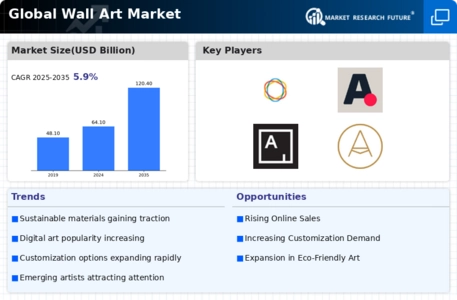Top Industry Leaders in the Wall Art Market
 The competitive landscape of the wall art market is characterized by a diverse array of players, each aiming to establish a strong foothold in the home décor industry. As of 2023, key players have solidified their positions, employing various strategies to cater to the diverse tastes of consumers and capitalize on the growing demand for decorative wall art.
The competitive landscape of the wall art market is characterized by a diverse array of players, each aiming to establish a strong foothold in the home décor industry. As of 2023, key players have solidified their positions, employing various strategies to cater to the diverse tastes of consumers and capitalize on the growing demand for decorative wall art.
Key Players:
Saatchi Art (U.S.)
Artfinder (U.K.)
Minted LLC. (U.S.)
Artspace LLC (U.S.)
Artsy (U.S.)
com (U.S.)
Zatista LLC (U.S.)
The Tellenge Store (India)
Artisera (India)
Seven Wall Art Corporation (U.S.)
Strategies Adopted:
Strategies adopted by these key players often revolve around assortment expansion, online presence, and customer engagement. IKEA, for instance, continually updates its wall art offerings to align with current design trends and seasonal themes. Amazon leverages its vast online platform to provide a diverse marketplace for both established and emerging artists, ensuring a wide range of choices for consumers. Bed Bath & Beyond emphasizes the curation of its in-store and online collections to align with evolving consumer preferences. Target focuses on collaborations with popular designers and artists to create exclusive and trendy wall art collections. Wayfair leverages its online presence and data-driven approach to recommend personalized wall art options based on customer preferences.
Market Share Analysis:
The wall art market is influenced by factors such as pricing, design variety, customer reviews, and supply chain efficiency. Companies that effectively balance affordability with quality, offer a diverse range of designs, and provide a seamless shopping experience tend to secure a larger market share. Additionally, effective digital marketing strategies, customer loyalty programs, and collaborations with influencers contribute significantly to market penetration.
News & Emerging Companies:
The wall art market have gained traction in 2023, leveraging online platforms and unique selling propositions to capture niche markets. Startups like Minted and Society6 have entered the market, focusing on connecting consumers with independent artists and offering customizable wall art options. While their market share may be relatively modest compared to industry giants, their emphasis on individuality and artistic expression has resonated with consumers seeking distinctive wall décor.
Industry Trends:
Industry trends underscore the increasing influence of e-commerce and technological advancements in the wall art market. Companies are investing in augmented reality (AR) and virtual reality (VR) technologies to allow customers to visualize how wall art will look in their homes before making a purchase. Additionally, investments in sustainable and eco-friendly materials for wall art reflect the industry's response to the growing demand for environmentally conscious products.
Competitive Scenario:
The wall art market reflects a balance between established players and emerging disruptors, all navigating a landscape shaped by e-commerce, design trends, and technological innovations. Key players maintain their dominance through extensive product assortments, brand recognition, and efficient supply chain management. Emerging companies contribute to the market's dynamism with a focus on artistic individuality, customization, and leveraging technology for enhanced customer experiences. The competition is further intensified by the entry of online marketplaces, niche players, and the increasing demand for sustainable and unique wall art options.
Recent Development
The wall art market is characterized by a mix of established players and emerging disruptors, all navigating a landscape shaped by e-commerce, design trends, and technological innovations. Key players maintain their market leadership through extensive product assortments, brand strength, and efficient operations, while emerging companies contribute to the industry's evolution with a focus on artistic individuality and technological integration. As the wall art market continues to evolve, companies that can effectively balance design trends, affordability, and personalized customer experiences are poised for success in this competitive and aesthetically driven segment of the home décor industry.











